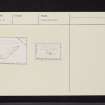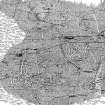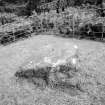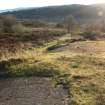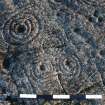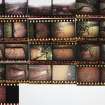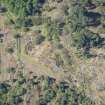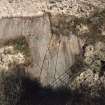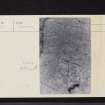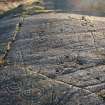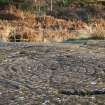Pricing Change
New pricing for orders of material from this site will come into place shortly. Charges for supply of digital images, digitisation on demand, prints and licensing will be altered.
Achnabreck
Cup And Ring Marked Rock(S) (Prehistoric)
Site Name Achnabreck
Classification Cup And Ring Marked Rock(S) (Prehistoric)
Canmore ID 39552
Site Number NR89SE 2
NGR NR 85570 90690
NGR Description Centred NR 85570 90690
Datum OSGB36 - NGR
Permalink http://canmore.org.uk/site/39552
- Council Argyll And Bute
- Parish Kilmichael Glassary
- Former Region Strathclyde
- Former District Argyll And Bute
- Former County Argyll
To the N of Achnabreck farmhouse lie several cup-and-ring marked rock outcrops. The largest, comprising three clusters of markings, forms the most extensive and impressive group of prehistoric rock-carvings in Scotland. Towards the lower end of the sheet there are carvings dominated by multi-ringed and guttered cups accompanied by an extensive network of grooves and, close to the base, a line of four exceptionally large plain cupmarks. At the centre of the sheet there is another group of multi-ringed cups and, higher up the outcrop, there is a third cluster of multi-ringed cupmarks.
Information from RCAHMS (1988)
NR89SE 2 centred 85570 90690
(NR 8557 9069) Inscribed Rock (NR)
OS 6" map (1924).
See also:
NR89SE 13 NR 85537 90197 Standing Stone
NR89SE 19 NR 85664 90564 Cup- and ring-marked rock
NR89SE 20 NR 85720 90655 Cup- and ring-marked rock
NR89SE 27 NR 857 906 Cup-marked rock
NR89SE 28 NR 860 903 Cup- and ring-marked rock
NR89SE 29 NR 862 904 Cup-marked rock
NR89SE 30 NR 862 903 Cup- and ring-marked rock
NR89SE 31 NR 862 903 Cup- and ring-marked rock
NR89SE 32 NR 864 903 Cup- and ring-marked rock
NR89SE 56 NR 85566 90814 Cup- and ring-marked rock
One of the largest groups of cup and ring markings known occurs on two contiguous rock faces 1/4 ml N of Achnabreck. The markings comprise cups, 1"-5" in diameter, and cups with from 1-7 rings. One on the upper face, a cup with seven rings, measures 3' in diameter. Most of the cup and ring marks have a radial groove; some have two. A double spiral marking occurs on the upper rock face. Almost all the markings are comparatively shallow.
R W Feachem 1963
A. The two contiguous rock faces measure 12.8m by 6.0m and 8.2m by 5.5m and bear 17 and 9 cup and ring marks respectively. Most have radial grooves with up to 6 rings and the largest measures 1.0m in diameter. There are also several single cup marks and various interconnecting channels.
B. 20.0m to the SW at NR 8555 9068, a sloping outcrop measuring 13.0m by 11.0m bears 47 cup and ring marks. Most have radial grooves with up to 8 rings and the largest measures 0.8m in diameter. There are also many single cup marks and various interconnecting channels.
C. (NR 8552 9065): a sloping outcrop, under guardianship, measures 7.0m by 4.0m and bears 15 cup and ring marks. Most have radial grooves with up to 5 rings, the largest being 0.6m in diameter. There are also many single cup marks and interconnecting channels.
Surveyed at 1:2500.
Visited by OS (DWR) 3 May 1973
The carvings at Achnabreck are fully described and illustrated by Morris.
R W B Morris 1974
No change to the report of OS (DWR).
Surveyed at 1/10,000.
Visited by OS (BS) 28 March 1977
Field Visit (3 May 1973)
A. The two contiguous rock faces measure 12.8m by 6.0m and 8.2m by 5.5m and bear 17 and 9 cup and ring marks respectively. Most have radial grooves with up to 6 rings and the largest measures 1.0m in diameter. There are also several single cup marks and various interconnecting channels.
B. 20.0m to the SW at NR 8555 9068, a sloping outcrop measuring 13.0m by 11.0m bears 47 cup and ring marks. Most have radial grooves with up to 8 rings and the largest measures 0.8m in diameter. There are also many single cup marks and various interconnecting channels.
C. (NR 8552 9065): a sloping outcrop, under guardianship, measures 7.0m by 4.0m and bears 15 cup and ring marks. Most have radial grooves with up to 5 rings, the largest being 0.6m in diameter. There are also many single cup marks and interconnecting channels.
Surveyed at 1:2500. (DWR)
Visited by OS (DWR) 3 May 1973
Field Visit (28 March 1977)
No change to the report of OS (DWR).
Surveyed at 1/10,000. (BS)
Visited by OS (BS) 28 March 1977
Field Visit (May 1984)
On rising ground to the N of Achnabreck farmhouse there are three cup-and-ring marked rock outcrops. The largest forms the most extensive and impressive group of prehistoric rock-carvings in Scotland (Campbell and Sandeman 1964, no. 201; PSAS 103, 33-56.).
(1) The major group of cup-and-ring markings is situated in an enclosure at the edge of a forestry plantation 350m N of Achnabreck farmhouse (Morris 1974). The undulating surface of the rounded outcrop is partially overgrown, and the decoration occurs as three discrete exposures which are here described from SW to NE.
The largest exposure lies at the foot of the enclosure and comprises three clusters of markings. Towards the lower end of the sheet there is a group dominated by multi-ringed and guttered cups (with up to seven rings) accompanied by an extensive network of grooves and, close to the base, a line of four exceptionally large plain cupmarks. At the centre of the sheet there is another group of multi-ringed cups and, higher up the outcrop, there is a third cluster of multi-ringed cupmarks.
The middle group is the smallest of the three decorated exposures. At the centre lies one of the largest cup-and-ring markings in Scotland, measuring up to 0.97m in diameter over the outermost of its seven rings, and it is accompanied on the S by a cup with a quadrant of three rings. To the NE and SE there are other multi-ringed cups, one of which has two central cupmarks, and all have well-defined gutters extending southwards from their cups. In addition to the larger marks there are several single-ringed cups and plain cupmarks.
The carvings on the upper sheet, which are concentrated at its N end with only a peripheral scatter elsewhere, comprise cups (some with gutters) and up to six rings, large numbers of plain cups, lengths of grooving (several of which form enclosures), and some modern graffiti. Amongst the concentration of carvings at the higher (N) end of the outcrop, there are two double spirals, one triple spiral, and several multiple rings (lacking central cups), which are of special interest (for further discussion, see the Introduction). These markings are badly weathered and worn, and in some instances they are overlain by other carvings; it is probable, therefore, that they represent an early phase of carving on the outcrop, predating the majority of the other cups and rings.
RCAHMS 1988, visited May 1984
Measured Survey (May 1984)
RCAHMS surveyed Achnabreck cup-and-ring markings on 20 June 1979 with plane-table and alidade producing a plan at a scale of 1:100. The plan of the cup-and-ring markings was redrawn in ink and published at a scale of 1:250 (RCAHMS 1988a, 87).
Publication Account (1985)
The rock sheets offer one of the most extensive displays of such carvings in Britain, with a bewildering profusion of multiple ring-markings, cups and grooves. On the first rock sheet there are over fifty cup-and-ring markings and many plain cup-markings, some of them unusually large; several of the figures are linked by grooves and many have grooves which run from the central cup. But it is the profusion of rings that is so striking. Up to nine rings surrounding the central cup have been counted; not all are circular, flattened sides are not uncommon. An early evening cross-light helps to capture both the decoration and the attractive colour of the rock.
At a distance of 30m to the north-west, the second area of carving has one of the largest cup-and-ring markings so far recorded, which measures almost 1m in overall diameter; seven rings surround a cup from which there are also two grooves.
The carvings on the highest part of the rock are not always easy to see, depending on lighting conditions, but contain some of the most unusual on the rock surface. Here, apart from cup-and-ring markings, there are double and triple-spiral motifs. It is possible that even further expanses of markings exist under the turf and heather, but in all cases where the markings are currently visible, they do not appear to extend under the turf.
The second fenced enclosure contains a denselypacked series of markings, many of the cup-and-rings joined by grooves to create patterns not unlike model railway networks. The rings are less regular than those of the larger rock-sheet, several figures containing more than one cup within the encircling rings.
Probably more has been written about the 'purpose' of such markings than any other archaeological imponderable; one view quoted by Sir James Young Simpson was that 'these circles are similar to those used in astronomical plates for elucidating the revolution of the planets round the sun'. Primitive calendars, maps of villages and acts of penance have all been suggested; whatever the reason, the social or religious pressures to continue what is a rather limited 'art-form' were clearly considerable.
Information from ‘Exploring Scotland’s Heritage: Argyll and the Western Isles’, (1985).
Excavation (1 October 1994 - 31 October 1994)
NR 855 906 Excavation at the site of cup-and -ring marked rock outcrops in Achnabreck Wood was undertaken by AOC (Scotland) Ltd in advance of the installation of new walkways, stiles, notice boards and a drain. In several small cuttings immediately adjacent to the carved rock exposure, the turf was stripped by hand and the topsoil layer was excavated to the subsoil surface. Though hitherto unexposed areas of bedrock were exposed, no new carvings were identified. Up to 10% of the topsoil was sieved in each area in an attempt to identify lithic debris associated with the carvings or their production, but no such material was identified. A group of linear features adjacent to the E or smaller carved outcrop is interpreted as ard or plough marks, but there is no evidence that these are associated with the carvings.
Sponsor: Historic Scotland with Forestry Enterprise.
J O'Sullivan 1995
Watching Brief (11 May 1998)
On 11/5/98 Kirkdale Archaeology monitored the digging of a drain against the downslope side of the Southernmost of the two carved surfaces at Achnabreck (NR 856 907). The drain was dug as a sinuous track some 3.5 m long, averaging 20 cm wide and reaching a maximum depth of 30 cm. Topsoil was represented by a very fine dark grey-black peaty silt, some 7- 8 cm thick, which overlay a 10-15 cm thick layer of light-dark grey fine silt. The drain bottomed on a compact light brown-orange fine, slightly clayey, silt with much iron panning, and frequent stone chunks - apparently similar to the carved bedrock outcrop.
Although small areas of bedrock were exposed, no new carvings were noted, indeed the motifs seem to be restricted to the relatively flat, upper surface. The trench was backfilled with Terram and gravel over a plastic pipe.No finds were retained

















































































